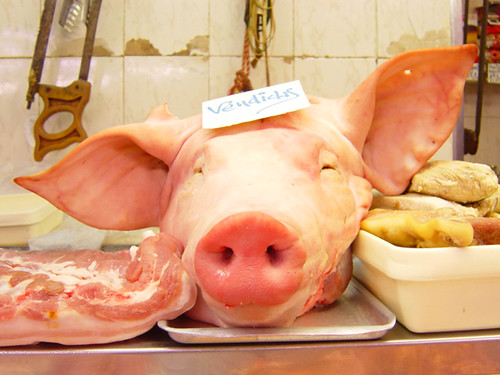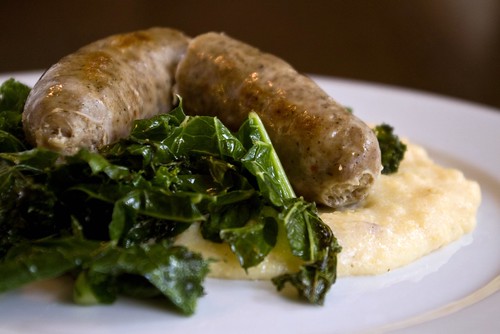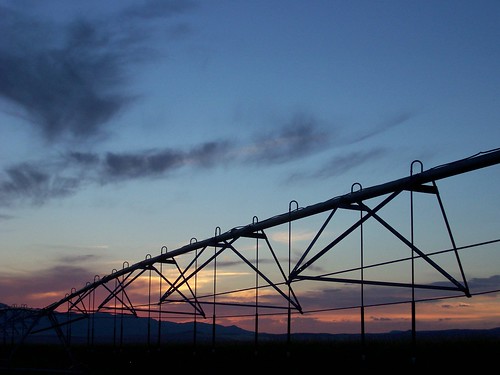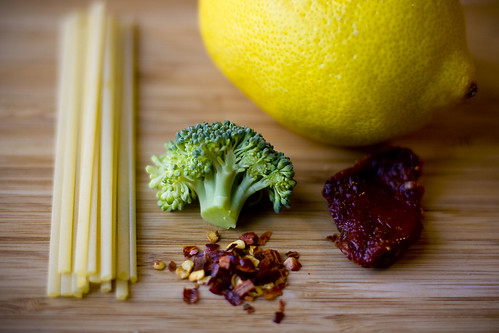12/30/08
Moving Day
10/13/08
More evidence on the dangers of high fructose corn syrup
As the Corn Refiners Association continues their pr campaign, more media sources are beginning to pay attention, though probably not with the intended results. First up, NaturalNews.com reinforces high fructose corn syrup's main ingredient is corn. While the ads ask, "What's wrong with corn?" the answer might just be, "Plenty."
Well here is another question that no one really thinks about. What is SO beneficial about corn? Corn is not a vegetable but a grain. Grains are metabolized into sugars very rapidly in the body and cause a huge spike in blood sugar, thus requiring an outpouring of insulin from the pancreas further straining this already so overworked organ. This is one of the major contributors to the massive increase in type II diabetes were seeing in modern times.
And Rebekah Denn, from the Seattle Post-Intelligencer cites an excellent point from Michael Pollan:
"Pollan says not to eat HFCS, but neatly breaks the standard impasse about whether HFCS is any more of a nutritional criminal than other sweeteners. Instead, here's Pollan's logic: HFCS is not necessarily harmful in and of itself, but it is one of the "reliable markers for foods that have been highly processed to the point where they may no longer be what they purport to be. They have crossed over from foods to food products."
By the way, Michael Pollan is rapidly becoming my new hero.
10/3/08
Feds shutter pesticide testing program
Photo credit: Shawn Econo
The Bush administration closed a government program that has tested pesticide levels "in fruits, vegetables and field crops" for the past eighteen years. The White House states the $8 million price tag is too steep, according to The Seattle Times:
Data from the 18-year-old Agricultural Chemical Usage Program administered by the U.S. Department of Agriculture (USDA) were collected until this year, and the Environmental Protection Agency (EPA) used the data to set safe levels of pesticides in food.
The information was also widely used by university and food-industry researchers, including a University of Illinois program to help farmers reduce the amount of pesticides they use.
One of the central philosophies that got us into the current financial mess is deregulation. As government turns a blind eye to corporate conduct, more in the corporate sector begin to cut corners, shave costs and increase profits. When it comes to hosing pesticides on crops, those costs may come in the form of Americans' well-being.
Would it have been more prudent to increase taxes on those industrial farmers who continue to use certain levels of pesticides? I'm not sure, but it seems like a sensible interim solution. Rewarding those farmers and companies who seek to lessen chemical influence on our food, environment, and our bodies, and have those who continue using chemicals help offset the cost of testing for those chemicals.
10/1/08
Wednesday Newsbites for 10/01/2008

photo credit: Left Hand Rotation
Why you should eat fat
Salon.com interviews Jennifer McLagan about her new book, Fat: An Appreciation of a Misunderstood Ingredient, With Recipes. In it she describes some of the benefits of eating animal fat over manufactured, polyunsaturated fats, and lingers on the succulent, savory taste fat brings to food. Just in time for World Vegetarian Day!
Many Foods Will Soon Be Labeled by Country of Origin
Finally we'll be able to tell whether or not the tilapia we're eating comes from California, Chile, or China.
Economy Bad, People Eat More at Home, Food Magazines Prosper
According to Serious Eats, via the Wall Street Journal, more people are eating at home and buying up magazines for recipe and food ideas. Makes sense, though why buy a magazine when you can just come here?
Instead of Eating to Diet, They’re Eating to Enjoy
The New York Times on people who eat for nutrition, enjoyment, and are "shunning deprivation diets and instead focusing on adding seasonal vegetables, nuts, berries and other healthful foods to their plates." Makes perfect sense. There's no need to go crazy trying to lose weight if you maintain balance in your diet.
Eat your water
Culinate.com cites a study in the journal Nutrition that indicates eating foods with a high water content will help you lose more weight than just drinking a lot of water.
9/30/08
October 1 is world vegetarian day

In celebration, eat a vegetarian! Just don't make it about speed because they're usually pretty nimble. Instead, use your meat-fueled endurance. If you stalk them patiently, they'll eventually tire and you can make your move.
The North American Vegetarian Society has dubbed October 1 World Vegetarian Day to celebrate the start of Vegetarian Awareness Month, a time to be aware of all vegetarians. Especially in traffic. But don't think the day opens some kind of hunting season. As disappointing as that may be to us omnivores, October is a time to ponder our diets, increase vegetable and fruit intake and eliminate meat, even if it's for just day.
Unless I take part in some kind of slaughter (something I must do one day, seriously), and decide on the spot to eliminate meat, I imagine beef, pork and fish will remain part of my diet forever. It's all far too delicious to do without. However, I am making a concerted effort to reduce the amount of meat I eat each week, especially after seeing Mark Bittman's TED talk and gaining a better understanding of the meat industry's environmental impact. So tomorrow, I'm going to see if I can make it one whole day without eating meat. I've got a batch of lentils already cooked up and plenty of fruits and vegetables in the crisper. If I get really hungry, though, vegetarians better watch out.
What can I do?
Take a day. Do without. And check WorldVegetarianDay.org for more ideas. Who knows? You might just surprise yourself and be healthier for it.
thanks to Slashfood.com
9/29/08
Lovely conversation with Alice Waters
From NYT:
Why do you think involving children in growing food and preparing it can make such a big difference for kids?
No other country thinks about food as just fueling up. It’s always connected to the seasons, to nature, to what’s growing, to celebrations with family and friends. It’s a kind of moment in the day when you collect your thoughts and stop to sit down and to eat. Food is considered precious and vital, and farmers are treasured. We’ve allowed ourselves to be completely indoctrinated into another way of thinking about food in this country.My solution is not to try to feed children in the same way that fast food nation does — which is to figure out a gimmick to get them to eat something. It’s to bring them into a whole relationship with food that’s connected to nature and our culture.
Spicy Cajun sausage with kale and maple bacon polenta

Several days ago I bought some Cajun sausage. I wasn't thinking about it. In fact, I planned to get a pork tenderloin for roasting, but the sausage was there, all fatty and delicious, and I suffered some kind of pork fugue. I snapped back to reality, sausage in my cart, blinking in the produce section's harsh flourescent lights. I brought the sausage home, stashed it in the back of the fridge, and promptly forgot about it. I never did get that pork tenderloin.
After a stressful week, I was desperate to cook this weekend. Just me, The Walkmen, and my stove. As I sorted through the fridge, I found the sausage. When I checked the date, I knew I'd have to use it for something. It wasn't going to last much longer. I checked with the family and learned my wife and daugther don't much care for red beans and rice or gumbo or jambalaya. What else do you make with Cajun sausage?. I was kind of stuck. I portioned up some of the sausage and used it for my own personal red beans and rice (delicious, thanks), and then set about to cook the remaining links. Pretty standard: place the links in a skillet with enough water to cover them half-way, bring to a boil, cover, reduce heat to medium-low, and let simmer for 15-20 minutes. Drain off the water, toss the links back in the pan, bring the heat up to medium-high and cook an additional 5 minutes, turning often. Once that's done, I wrapped the sausages in foil to keep them warm.
Thinking about flavors is the part of cooking I love most. There I was, cooked sausage links on hand wondering what to do with them. The meat wasn't really andouelle, but it did have some nice spice to it. I looked for balancing flavors, found the bitter kale in the crisper, the salty bacon in the cheese drawer, and the sweet maple syrup in the pantry. Real maple syrup, not that garbage that's made by adding maple flavoring to high fructose corn syrup. Also in the pantry I found polenta, which I quickly dubbed grits and was happy.
Southern-style sausage with kale and maple bacon polenta
Ingredients (for two)
- 2 strips of high-quality bacon (there's a difference)
- 2 large handfuls of kale or other greens
- 2 sausage links (prepared as above)
- Polenta (approx. 2/3 cups, total) You can use grits--they're nearly the same
- Polenta is made with yellow corn, grits with white
- Equal parts milk and water (approx. 2 cups, total)
- kosher salt
- 1 tablespoon butter
- 1 tablespoon maple syrup
1. Start by rendering the bacon fat. To do so, set the bacon strips in a nice-sized skillet (one with a lid or other cover) and turn the burner on medium. Leave the bacon alone and let it come up to heat with the pan.
2. While the bacon heats, start in on the polenta. Mix the water and milk in a medium sauce pan. Add the butter and a good-sized dash of salt. Turn the burner up to medium-high and wait.
3. Check on that bacon. If it's beginning to sizzle, go ahead and flip it. Let it sit almost two minutes on that side, then flip it back over; let it sizzle away about another minute, then bring it off the heat and allow it to drain on some paper towels.
4. Toss the handfuls of kale into the bacon pan. The greens will sizzle and pop, and that's ok. Go ahead and give them a stir in the bacon fat, lower the heat to medium-low and cover the skillet.
5. Back over at your sauce pan, your milk and water mixture will probably be coming to a boil. Reduce the heat to medium and begin whisking in your polenta. It should begin to come together pretty quickly. If it seems too runny after a couple minutes of stirring, whisk in some more polenta. If it seems too thick, add some water, milk or even a little cream. You'll want a texture smooth enough to spread on a plate but thick enough to hold its shape. When you get that consistency, reduce to low heat and cover. You'll let this sit about 8 minutes.
6. Stir your kale. When it's just wilted, remove it from the heat, but don't take it out of the pan. It can sit and steam all on its own.
7. Now, crumble the bacon and stir it into the polenta. Give it a taste, add necessary seasoning, then slowly add the maple syrup. You'll be surprised how flavorful the real stuff is, so add a few drops at a time and taste, taste, taste! When you have a good mix of salty and sweet, you're all set.
To plate, spread the polenta first, add the kale, and then nestle the sausage link right on top. To add a fragrant garnish, place a whispy sprig of rosemary on top of everything.
Each bite of the spicy sausage in this rustic, hearty dish blends with the grassy, slightly bitter kale and the wonderfully silky, salty, sweet polenta to delight all tastebuds.
9/26/08
Friday fundamentals: meat rest
Cooked meat has been through a lot. Exposure to heat excites cells, alters secondary and tertiary peptide bonds (science!) and denatures proteins. Makes them contract. It can be messy business and is why a freshly cooked, cut steak spills so much juice on your cutting board. To make sure that juice ends up where it's supposed to--your stomach--let cooked meat rest.
By cooked I mean seared, grilled or roasted. By meat I mean beef, pork or whole-roasted poultry. By rest I mean leaving it alone. When you pull the meat out from under the broiler, off the grill or out of the pan, just let it sit for a while. A pan seared flat-iron steak does best with about five to ten minutes of resting. A whole roasted turkey will benefit most from a thirty minute break. She needs her space; she's probably been through a lot.
If you're baking a sad, skinless chicken breast then don't even bother with the resting. It's bland food and won't benefit. Just wrap it in a pita and take it to your punishment corner.
What does resting do?
Resting enables the meat's juices to redistribute into the cells. Cooked meat suffers trauma. The heat denatures proteins in the cells and fundamentally changes the secondary and tertiary bonds between protein molecules. The most common, immediate change is tightening. The bonds tighten, the molecules contract, and the juice is squeezed out around the newly formed protein core. Once the protein molecules begin to cool however, they let some of those juices back in. Also, as the temperature throughout the meat begins to reach equilibrium, the juices are redistributed through most cells.
What about fish?
Most fish shouldn't be rested. After meat is cooked, it retains residual heat, which will continue warming the meat's center mass. This warming is, in essence, a continuation of the cooking process, and if you've ever had overcooked fish, you know you don't want to risk it. Pan to plate to stomach. Fast as possible.
Resting meat is one of those small tricks they never used to tell us but one that is absolutely essential to enjoying an excellent meal. Now you know why.
9/25/08
Mark Bittman: what's wrong with the food we eat
A sobering talk from 2007:
It makes me wonder how long a single cow could feed my family and whether or not that option is even open to me. I bet the answers are a long time and no.
Thanks to Cooking up a Story
Food photography lessons from Vegan Yum-Yum
A commenter asked me to a do a food photography tutorial. I'm honored by the request and still plan to put together a short film detailing some of my techniques. Until then, I'd like to direct you to a comprehensive food photography tutorial courtesy of Vegan Yum-Yum. An excerpt:
Plan Ahead
Do as much as you possibly can ahead of time. Food should be photographed as soon as possible after preparing, which means you’ll need a space for photographing ready to go, an uncluttered kitchen, etc. Here’s what I do before I start cooking:
- Clean up, do all the dishes, clear countertops
- Pick out dishes
- Set camera up on tripod, pick out background
- Clear your photography space
- Think about the dish: do you need a garnish? Special utensils? Placemat?
Mise en Place
Prepping all your ingredients neatly will keep your kitchen more organized, cut down on cooking time, and allow you to focus on the task at hand. And mise en place photographs make for killer filler photos, as well!
There are a few key take-aways from Lolo's post. First, do a little prep work. Being organized and having a clear idea of what you want to accomplish will do much for your photography. Also, use natural light if you can get it.
I have neither time, resources, nor the inclination to purchase a lot of festive dishes. I have white plates and some dark plates and those mostly suit my needs. The one thing I might recommend, if you're really pressed and want to take one step towards a prop closet is a rustic, earthy bowl. I'm thinking of purchasing one--wide and shallow--for soup photos this coming winter.




